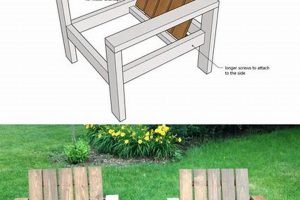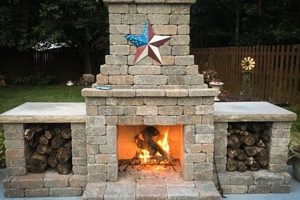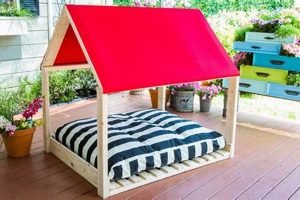A self-constructed external wood-burning heating system utilizes a fan to distribute heated air throughout a building. This method involves building a firebox outside the structure, typically from steel or repurposed materials, and integrating a heat exchanger. A blower circulates air through the exchanger, transferring heat to the air, which is then ducted into the building’s existing ventilation system or a separate network of ducts.
This approach offers the potential for significant cost savings on heating bills by using a renewable fuel source. Historically, wood-burning furnaces provided a primary heat source in rural areas, with the “forced air” component representing a modernization that increases efficiency and distribution range. Benefits can include reduced reliance on fossil fuels and greater energy independence, particularly where wood resources are readily available and affordable. However, careful consideration must be given to safety regulations, emissions standards, and efficient design for optimal performance.
Understanding the essential components, design considerations, and safety protocols is crucial before embarking on such a project. This article will now delve into the specifics of materials selection, construction techniques, integration with existing heating systems, and necessary safety measures to ensure both efficient and safe operation of this type of heating system.
Practical Guidance for External Wood-Fired Forced-Air Systems
The following recommendations aim to provide practical guidance for those considering or actively involved in the design, construction, or maintenance of a wood-fueled, forced-air heating apparatus located outside the primary structure.
Tip 1: Material Selection: Utilize high-grade steel for the firebox construction. The steel’s thickness and composition should be adequate to withstand the high temperatures and thermal stress generated during prolonged operation. Consider using refractory materials to line the firebox for improved heat retention and protection of the steel.
Tip 2: Heat Exchanger Design: Optimize the heat exchanger’s surface area to maximize heat transfer efficiency. A larger surface area allows for more effective absorption of heat from the firebox exhaust. Consider incorporating baffles or turbulators within the heat exchanger to increase turbulence and improve heat transfer.
Tip 3: Air Blower Sizing: Correctly size the air blower to ensure adequate airflow through the heat exchanger and ductwork. An undersized blower will result in insufficient heat distribution, while an oversized blower may create excessive noise and energy consumption. Consult engineering guidelines to determine the appropriate blower capacity for the system’s heating requirements.
Tip 4: Ductwork Insulation: Insulate all ductwork to minimize heat loss during air distribution. Uninsulated ducts can significantly reduce the system’s overall efficiency, leading to higher wood consumption. Use appropriate insulation materials and sealing techniques to prevent air leakage.
Tip 5: Safety Clearances: Maintain adequate clearances between the firebox and any combustible materials. Adhere to local building codes and regulations regarding minimum clearance distances to prevent fire hazards. Install a spark arrestor on the chimney to reduce the risk of airborne embers.
Tip 6: Regular Maintenance: Implement a regular maintenance schedule to ensure optimal performance and longevity. This includes inspecting the firebox for signs of corrosion or damage, cleaning the heat exchanger to remove soot and ash buildup, and lubricating the air blower motor. Regular maintenance will help prevent breakdowns and extend the system’s lifespan.
Tip 7: Combustion Air Supply: Ensure an adequate supply of combustion air to the firebox. Insufficient combustion air will result in incomplete combustion, leading to increased smoke emissions and reduced efficiency. Provide dedicated air vents or ductwork to supply the firebox with sufficient oxygen.
These guidelines aim to assist in the responsible and effective application of wood-fueled external heating technologies. Attention to these factors is expected to improve heating performance and overall system longevity.
The subsequent section will elaborate on specific construction techniques and relevant regulatory standards that should be followed meticulously.
1. Design Efficiency
Design efficiency is a critical determinant of the overall performance and cost-effectiveness of a self-built external wood-burning forced-air heating system. The inherent objective of such a heating solution is to provide an alternative, often lower-cost, heating source. Inefficient design directly negates this objective by increasing fuel consumption and decreasing heat output. For instance, a poorly designed firebox, lacking proper insulation or an optimized combustion chamber, will waste wood by allowing heat to escape and preventing complete combustion. This results in lower air temperatures at the output, necessitating increased wood consumption to achieve the desired heating effect.
A well-designed heat exchanger maximizes heat transfer from the firebox exhaust to the circulating air. Insufficient surface area or improper flow baffling within the heat exchanger hinders this transfer, reducing the system’s overall efficiency. In practical terms, a heat exchanger with suboptimal design may require the forced air system to run for extended periods to heat a specific space, leading to increased wear and tear on the blower motor and ductwork, as well as higher fuel consumption. Conversely, a system incorporating design elements such as a secondary combustion chamber or an efficient multi-pass heat exchanger can significantly reduce wood consumption while maintaining or even increasing heat output.
In conclusion, the design efficiency of a system profoundly impacts its practical viability. Prioritizing efficient design not only minimizes operating costs through reduced fuel consumption but also enhances the system’s longevity and minimizes environmental impact by promoting cleaner combustion. Overlooking this key aspect can render the entire project economically and environmentally unsustainable. Therefore, thorough planning and optimization of the design are essential prerequisites for a successful implementation.
2. Material Durability
Material durability is a paramount consideration in the construction of any external wood-burning forced-air heating apparatus. The system’s operational environment, characterized by high temperatures, corrosive byproducts of combustion, and exposure to the elements, necessitates the use of robust materials capable of withstanding these stresses over extended periods. The longevity and safety of the entire installation are directly contingent on the selection of appropriate and durable materials.
- Firebox Steel Composition
The firebox, being the heart of the system, requires steel of a specific grade and thickness. Mild steel, while initially cost-effective, is susceptible to oxidation and warping under sustained high temperatures. Alloys containing chromium and nickel, such as stainless steel or certain grades of weathering steel, offer superior resistance to corrosion and heat-induced deformation. Proper thickness is also vital; thinner gauges are prone to premature failure, necessitating costly repairs or complete replacement of the firebox.
- Heat Exchanger Integrity
The heat exchanger’s function is to transfer heat from the combustion gases to the circulating air. The material used must efficiently conduct heat while resisting corrosion from acidic condensates formed during combustion. Copper or aluminum, while excellent conductors, may not be suitable due to their susceptibility to corrosion from flue gases. Steel, again, is a common choice, but its longevity depends on its coating or alloy composition. Proper maintenance, including regular cleaning, is necessary to prevent the accumulation of corrosive deposits.
- Ductwork Endurance
Ductwork materials must withstand not only the elevated temperatures of the heated air but also the external environmental conditions if the ductwork is partially or fully exposed. Galvanized steel is a common choice for ductwork due to its resistance to rust. However, in highly corrosive environments, alternative materials such as aluminum or insulated flexible ducting may be preferable. The connections between duct sections should be robust and airtight to prevent heat loss and ensure efficient air distribution.
- Insulation Stability
Insulation plays a critical role in maintaining the system’s efficiency by minimizing heat loss. The insulation material must be capable of withstanding high temperatures without degrading or releasing harmful substances. Materials such as mineral wool or ceramic fiber are commonly used due to their thermal stability and fire resistance. Proper installation and sealing of the insulation are essential to prevent moisture ingress, which can compromise its effectiveness and lead to corrosion of adjacent metal components.
The interconnectedness of these material choices underscores the holistic approach required for constructing a reliable and long-lasting external wood-burning forced-air heating system. Compromising on material quality in any one component can jeopardize the entire system’s performance and lifespan. Adherence to recognized engineering standards and best practices in materials selection is therefore essential to ensure a safe, efficient, and durable heating solution.
3. Airflow Optimization
Airflow optimization is a critical factor determining the performance of a self-built external wood-burning forced-air heating system. Inefficient airflow directly impairs heat transfer and distribution, reducing the system’s overall effectiveness and potentially leading to overheating or uneven heating. The design and implementation of the forced-air component significantly influence the system’s ability to efficiently deliver heat to the intended space. Cause and effect are readily apparent: restricted airflow reduces heat output, while optimized airflow maximizes heat delivery. For instance, undersized ductwork or improperly positioned vents will impede airflow, resulting in cold spots within the heated area and increased fuel consumption as the system struggles to maintain the desired temperature.
The strategic placement of intake and exhaust vents, coupled with appropriate duct sizing, is paramount. Natural convection currents, though minimal in forced-air systems, can influence airflow patterns. Careful consideration should be given to the building’s layout and insulation characteristics. For example, a poorly insulated building will require a higher volume of heated air to maintain a comfortable temperature, necessitating a more robust forced-air system and optimized ductwork configuration. The selection of the blower fan is also crucial. An improperly sized fan may either fail to provide sufficient airflow or consume excessive energy. Practical application involves using computational fluid dynamics (CFD) simulations to model airflow patterns and identify potential bottlenecks or areas of poor circulation.
Effective airflow optimization hinges on a comprehensive understanding of the system’s design parameters, the building’s thermal characteristics, and the appropriate selection of components. Addressing airflow limitations is essential to maximizing the efficiency, safety, and comfort provided by a DIY external wood furnace. Challenges may include retrofitting existing ductwork or adapting the system to complex building layouts. However, the practical significance of proper airflow management cannot be overstated, as it directly impacts both heating performance and fuel economy.
4. Safety Protocols
The implementation of stringent safety protocols is non-negotiable when constructing and operating a self-built external wood-burning forced-air heating system. The inherent risks associated with high temperatures, combustion byproducts, and the potential for fire demand meticulous attention to safety at every stage of the process. Failure to adhere to established safety guidelines can result in property damage, personal injury, or even loss of life. The following elements represent critical safety considerations:
- Clearance Distances and Fire Suppression
Maintaining adequate clearance between the wood furnace and any combustible materials is paramount. This includes buildings, fences, vegetation, and fuel storage areas. Local building codes typically specify minimum clearance distances that must be strictly observed. Additionally, readily accessible fire suppression equipment, such as fire extinguishers and water hoses, is essential in the event of a fire. Regular inspection and maintenance of this equipment are imperative to ensure its proper functionality.
- Chimney and Flue Design and Maintenance
The chimney and flue system must be designed and installed according to established standards to ensure proper venting of combustion gases. This includes selecting the appropriate materials, ensuring proper draft, and maintaining adequate height. Regular inspection and cleaning of the chimney are necessary to prevent the buildup of creosote, a highly flammable substance that can lead to chimney fires. A spark arrestor should be installed to prevent the ejection of embers, which can ignite nearby vegetation or structures.
- Carbon Monoxide Detection and Ventilation
Carbon monoxide (CO) is a colorless, odorless, and highly toxic gas produced during combustion. The installation of CO detectors in the heated building is essential to provide early warning of CO leaks. Proper ventilation of the furnace area is also critical to prevent the buildup of CO. This may involve installing vents or exhaust fans to ensure a constant supply of fresh air.
- Electrical Safety and Grounding
The electrical components of the forced-air system, including the blower motor and any control systems, must be installed and maintained according to electrical codes. Proper grounding is essential to prevent electrical shock. All wiring should be protected from physical damage and exposure to moisture. A qualified electrician should be consulted for any electrical work.
These safety protocols are inextricably linked to the safe and reliable operation of a DIY external wood furnace. While the potential for cost savings and energy independence may be attractive, neglecting these critical safety considerations can have devastating consequences. Compliance with relevant regulations, adherence to best practices, and continuous vigilance are essential to mitigate the risks associated with this type of heating system. The integration of these safety measures transforms a potentially hazardous undertaking into a responsible and sustainable heating solution.
5. Emissions Control
Emissions control is a critical aspect of operating any wood-burning appliance, and its importance is amplified in the context of self-constructed external wood-burning forced-air heating systems. These systems, often built and operated without the oversight and optimization inherent in commercially manufactured units, can present significant challenges in terms of air pollutant emissions. Effective emissions control strategies are therefore essential to mitigate the environmental impact and ensure compliance with local regulations.
- Combustion Efficiency and Technology
The efficiency of the combustion process directly influences the quantity and composition of emissions. Incomplete combustion results in higher levels of particulate matter (PM), carbon monoxide (CO), and volatile organic compounds (VOCs). Utilizing designs that promote complete combustion, such as staged combustion or secondary air injection, can significantly reduce these emissions. Furthermore, catalytic converters can be integrated into the exhaust stream to further oxidize pollutants and reduce emissions. Real-world examples include EPA-certified wood stoves that employ advanced combustion technologies to meet strict emissions standards. The implications for systems lacking such technologies are higher emission levels and potential regulatory non-compliance.
- Fuel Type and Moisture Content
The type and quality of wood fuel burned have a substantial impact on emissions. Burning seasoned, dry wood minimizes the release of particulate matter and other pollutants compared to burning green or wet wood. The moisture content of the wood affects combustion temperature and efficiency. Properly seasoned wood burns hotter and cleaner, leading to lower emissions. For instance, using hardwoods like oak or maple generally results in lower emissions compared to softwoods like pine. The implications for are that consistent usage of properly sourced and seasoned wood is imperative for minimizing emissions.
- System Maintenance and Operation
Regular maintenance is critical for ensuring optimal combustion and minimizing emissions over time. This includes cleaning the chimney and flue to prevent creosote buildup, inspecting and maintaining air inlets to ensure proper airflow, and regularly checking for leaks in the firebox or exhaust system. Overfiring or improper loading of the firebox can lead to increased emissions. Proper operation, including following manufacturer’s recommendations for fuel loading and air control settings (where applicable), is essential. The implications of neglecting maintenance are increased emissions, reduced efficiency, and potential safety hazards.
- Regulatory Compliance and Monitoring
Local, state, and federal regulations often govern wood-burning appliances, including restrictions on emissions levels and operating conditions. Compliance with these regulations is essential to avoid penalties and ensure environmental responsibility. In some areas, permits may be required for installing or operating wood-burning systems. Monitoring emissions levels, either through visual inspection or the use of monitoring equipment, can help ensure that the system is operating within acceptable limits. Real-world implications involve potential fines and legal action for non-compliance, underscoring the need for awareness and adherence to applicable regulations.
The interplay between combustion efficiency, fuel quality, maintenance practices, and regulatory compliance underscores the multifaceted nature of emissions control in DIY systems. While these systems may offer cost-effective heating solutions, responsible operation necessitates diligent attention to emissions reduction strategies. Neglecting emissions control not only contributes to air pollution but also undermines the long-term sustainability of wood-fired heating as a viable energy alternative.
6. Cost Effectiveness
The economic viability of a self-constructed external wood-burning forced-air heating system is a primary driver for many individuals considering this alternative heating method. However, a thorough assessment of cost effectiveness requires considering not only initial expenses but also long-term operational costs, maintenance requirements, and potential hidden expenses. This analysis aims to provide a comprehensive overview of the cost implications associated with such a system.
- Initial Investment versus Commercial Alternatives
The most immediate cost consideration is the initial investment required to build the system. This includes the cost of materials such as steel, refractory materials, a blower fan, ductwork, and safety components. While self-construction can potentially reduce costs compared to purchasing a commercially manufactured outdoor wood furnace, this reduction hinges on the ability to source materials economically and possess the necessary fabrication skills. For example, utilizing repurposed materials or obtaining discounted supplies can significantly lower the initial outlay. However, the labor involved in fabrication and installation must also be factored into the equation.
- Fuel Costs and Wood Sourcing
A significant factor influencing long-term cost effectiveness is the expense associated with wood fuel. The cost of wood varies considerably depending on location, availability, and the method of acquisition. Gathering wood from one’s own property may reduce costs substantially, while purchasing wood from a supplier introduces an ongoing operational expense. Fluctuations in wood prices, influenced by seasonal demand and market conditions, can impact the overall cost savings. Furthermore, the efficiency of the combustion process directly affects wood consumption; an inefficient system will require more wood to generate the same amount of heat, thereby increasing fuel costs.
- Maintenance and Repair Expenses
Maintenance and repair costs represent another critical element in assessing long-term economic viability. Self-built systems may require more frequent maintenance and repairs compared to commercially manufactured units due to the potential for design flaws or the use of less durable components. Regular maintenance tasks, such as chimney cleaning, firebox inspection, and component lubrication, require both time and resources. Unexpected repairs, such as replacing a worn-out blower fan or repairing a corroded firebox, can significantly increase the overall cost of ownership. A proactive maintenance schedule can mitigate the risk of costly repairs, but it also represents an ongoing expense.
- Hidden Costs and Opportunity Costs
Several potential hidden costs can impact the overall cost effectiveness. These may include the expense of obtaining necessary permits and inspections, the cost of tools and equipment required for construction and maintenance, and the potential for increased insurance premiums. Opportunity costs, such as the time spent constructing and maintaining the system rather than pursuing other income-generating activities, should also be considered. Accurately accounting for these less obvious expenses is essential for a comprehensive cost-benefit analysis.
A comprehensive cost assessment of this heating solution demands consideration of both immediate and long-term financial implications. The potential for cost savings relative to conventional heating methods depends heavily on factors such as materials sourcing, wood availability, the efficiency of system construction, and consistent maintenance. Overlooking any of these elements could significantly alter the perceived cost-effectiveness and compromise the project’s financial viability, so it is important to take due dilligence before starting the process.
Frequently Asked Questions
This section addresses common inquiries and concerns regarding the design, construction, and operation of do-it-yourself outdoor wood furnace forced air heating systems.
Question 1: Is building an external wood furnace and forced air system a viable alternative to purchasing a commercial unit?
The economic viability depends on factors such as access to affordable materials, proficiency in welding and fabrication, and availability of low-cost or free wood fuel. A thorough cost-benefit analysis is recommended before commencing construction.
Question 2: What are the primary safety hazards associated with self-constructed outdoor wood furnaces?
Key hazards include fire risk due to inadequate clearance from combustibles, carbon monoxide poisoning from incomplete combustion, and electrical shock from improper wiring. Adherence to safety protocols and local building codes is essential.
Question 3: What type of steel is recommended for the firebox construction?
High-grade steel with sufficient thickness to withstand high temperatures and thermal stress is necessary. Alloys containing chromium and nickel offer improved resistance to corrosion and heat-induced deformation.
Question 4: How can emissions from an external wood furnace be minimized?
Strategies include burning seasoned wood, ensuring adequate airflow for complete combustion, maintaining the system regularly to prevent creosote buildup, and utilizing designs that incorporate secondary combustion.
Question 5: What considerations are important when sizing the blower fan for a forced air system?
The blower fan must be sized appropriately to provide sufficient airflow through the heat exchanger and ductwork. Undersized blowers result in inadequate heat distribution, while oversized blowers consume excessive energy.
Question 6: What measures should be taken to insulate the ductwork effectively?
All ductwork should be properly insulated to minimize heat loss during air distribution. Insulation materials must be suitable for high temperatures, and sealing techniques should prevent air leakage.
In summary, constructing and operating a system requires comprehensive knowledge and adherence to industry best practices.
The following section will delve into regulatory standards.
diy outdoor wood furnace forced air
This article has explored the multifaceted aspects of constructing a self-built external wood-burning forced-air heating system. Key areas of focus included design efficiency, material durability, airflow optimization, adherence to strict safety protocols, rigorous emissions control, and a realistic assessment of overall cost effectiveness. Each element requires careful consideration and precise execution to ensure a system that is both functional and safe.
The decision to undertake such a project demands a comprehensive understanding of the inherent challenges and potential risks. Prior to implementation, individuals should meticulously evaluate their capabilities, resources, and the potential impact on the environment. Thorough research, adherence to relevant regulations, and a commitment to safety are imperative to ensure a responsible and sustainable heating solution.







